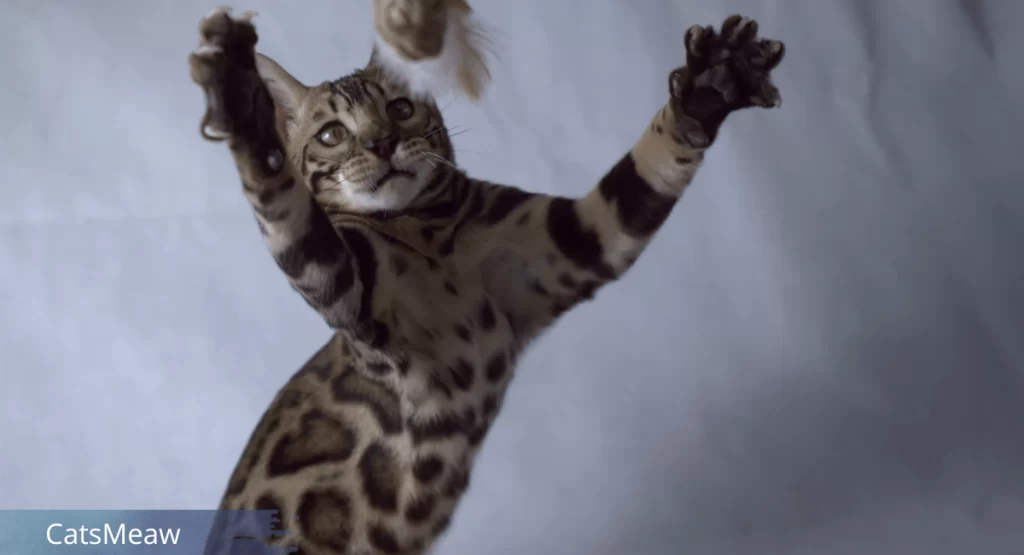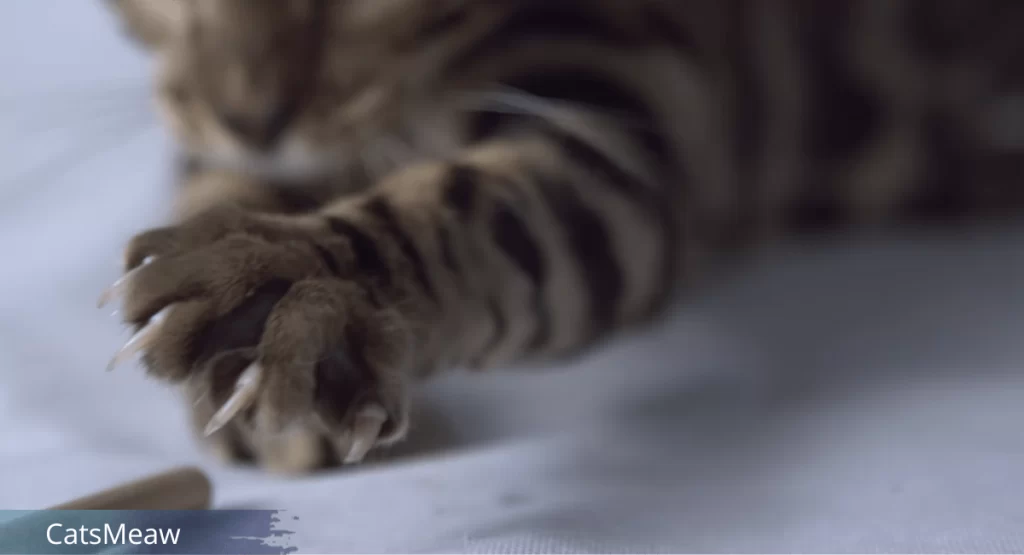Retractile, but slender, the claws of our velvet paws prove formidable for those who suffer from a paw. It’s better not to annoy our cats or be prey if you don’t want to test the power of their weapons. Retractable, our little cats choose to take them out wisely and maintain their efficiency, most often alone, by scratching everyday objects or trees when they are enjoying the outdoors.

Table of Contents
Anatomy of the cat’s paw
Defense weapons or profiled for hunting, the cat’s claws also serve as crampons for our adorable climbers. They also participate in marking the territory.
Very sensitive pads
Small felids walk on their fingertips. Unlike us, they do not have soles of their feet and roam around on their toes to monitor and maintain their territory. The pads are the rudiment of the thumb for us. Very sensitive, because they are highly innervated, they have no fur and are made up of fatty and fibrous masses.
The front legs have 5 fingers, a pad for each finger and the palmar pad, shaped like a clover. The hind legs have only 4 digits, 4 digital pads and a palmar pad. Like the dog, the pads are surrounded by sweat glands which allow the cat to evacuate heat and this is not their only function. They are also :
- Anti-slip;
- Receptive to vibrations;
- Carriers of the olfactory messages that the feline leaves when it scratches a tree trunk or your sofa.
Extremely well profiled, the paws of our cats also serve as a braking system: the parts of the paw that do not touch the ground serve as ABS when they descend along a tree trunk.
Claws with multiple potentials
Mobility ensured by elastic ligaments, the cat’s claws are retractable. Tucked completely inside the fingers, these offensive and defensive weapons come out reflexively. Made up of two parts, the claw is made up, like our nails, of a living and sensitive part: the pink part located at the base of the finger. The second part is called “dead”. It is made up of keratin, like hair.
It can be white, transparent or black. The living part should never be cut, because it has nerves and small blood vessels. Cat’s claws grow 2 to 4 millimeters per month. For cats who live exclusively in an apartment, it is preferable to thin them or cut them regularly. You can call your veterinarian for this treatment or a professional groomer.
Related: Best Guide to Trimming Your Cat’s Nails
To extend its claws, the cat must contract its fingers. It therefore does not wear them out by walking, but by scratching any object likely to suit this need.
Functional and useful claws for all felines
If the claws are primarily used to defend itself or to hunt, they allow the animal to climb vertical surfaces such as trees, your curtains or the carpet placed on the walls when this interior decoration was fashionable. Scratching is not only used to wear down and thin your cat’s claws into a deadly weapon: it also helps mark its territory. To prevent your cat from marking the sofa and furniture, offer it a scratching post or make one. Minou will thus be able to deploy its instincts without damaging your furniture.
Hunt and defend yourself

Deadly weapons for the small vertebrates and invertebrates that it hunts, the claws also allow your animal to defend itself in the event of an attack from a predator or during a fight between peers. However, when you play with your small animal, this reflex act can very quickly become painful for you. You can of course teach your feline to become a real velvet paw, however, to avoid scratching, having fun with toys rather than your hands remains the best prevention.
To hold on is to relax or to strengthen your muscles
For our feline companions, claws are not only lethal weapons. Scratching and clawing develops and maintains the flexibility of their joints. These habits strengthen their leg muscles and give them a reassuring feeling of control over their territory. They also allow them to release stress or excess energy. Scratching is sport, relaxation and hygiene all at the same time.
A hygienic scratch
In addition to providing well-being, the cat maintains its claws. To wear them out and maintain their effectiveness both for climbing and defending themselves, the cat wears out its claws by attacking your furniture or trees. It thus eliminates damaged parts and edges to better attack or deal with a potential predator. By frantically scratching an object, the cat cleans its paws of dust, dirt or parasites that may cling to them.
Claws to transmit messages
Our little balancing artists don’t just use their claws to maintain stability. Scratching also allows them to communicate their emotions, to signal their presence, to defend their territory or to greet a friend. When your four-legged friend scratches a tree or any other surface, it leaves olfactory messages using the sweat glands placed between its pads. These marks made of pheromones tell other cats in the neighborhood that they have been there.
If this marking can signal that a territory belongs to them, it can also be used to greet a fellow creature, warn of danger or indicate the annoyance of your feline. Who has never seen their cat frantically grabbing onto the chair because you didn’t open the door quickly enough?
Scratching remains a fundamental function for the balance of our cats, whether they enjoy the great outdoors or live exclusively indoors. Ensuring the health of their claws and offering them objects to satisfy this natural need remains essential to the good health of our felines.
How to take care of your cat’s claws?
Even if your cat goes outside regularly, it is crucial to monitor the health of its claws. Take the time to monitor paws, pads and interdigital spaces. Make sure your pet does not suffer from injuries or irritations. If this is the case, consult your veterinarian who will prescribe the necessary care. Likewise, if it is limping, observe and when it is calm, take a closer look at the paw to check that there is no injury or infection. If one or more claws come out while its paw is relaxed, it is because these claws are too long. If any of them curve toward the pad, make an appointment with your veterinarian. To see your cat’s claws, lightly press on its pad and check their condition and length.
Cutting the cat’s claws
When the cat walks in gardens and streets, it wears its claws on trees and you will not normally need to cut it. When living exclusively indoors, the scratching post alone is generally not enough. To maintain them, you can call your veterinarian, the groomer or arm yourself with nail clippers designed for your four-legged friend.
Related: Infected Cat Claws: Causes & Best Treatment
Depending on the growth, cutting will be done once or twice a month. It is best to accustom your kitten to this treatment very quickly so that maintaining their claws remains a pleasant time for everyone. If your cat is reluctant, carry out the trimming in pairs rather than alone and remember to reward your cat with a treat at the end of the treatment.
Maintaining the polydactyl cat’s claws
Some cats cheat and are not satisfied with 18 fingers and 18 claws. When this is the case, the supernumerary claw is located on the front paw, between the thumb and index finger. This often problematic extra claw requires regular maintenance and pruning. If your cat is polydactyl, it is best to seek advice from your veterinarian about trimming its claws.
Scratching posts for stretching, scratching and maintaining the well-being of your feline
The scratcher is an essential for the apartment cat. Its use allows the animal to wear its claws, relax and build muscle, mark its territory while protecting your furniture. Alone or directly integrated into the cat tree, some felines shun it. How to choose it well and encourage your cat to prefer it to your furniture?
Choosing the ideal scratching post
If stability is essential, the ideal scratching post should be arranged vertically to keep your kitty interested. Indeed, this more natural position will remind it of the tree trunk. However, you can offer it several scratching posts with different inclinations to satisfy all its needs: stretching, marking, deploying and training its paw muscles. You can offer a simple square of carpet as a horizontal scratching post.
Textures
In terms of texture, you have the choice of materials and it is your cat who will tell you which one it prefers. It is advisable to test different low-cost supports before investing in a scratching post that will suit you perfectly. Cardboard has the advantage of being light and easy to transport, but it wears out quickly and leaves many flakes decorating your house when your cat uses it.
The sisal that surrounds the board is a material very popular with our felines, in general. It has the advantage of being solid and stable. When the sisal rope is too worn, simply replace it. Felt remains a good alternative to sisal, however replacing worn fabric remains more expensive.
The different types of scratching posts to help kitty wear out their claws
To be fixed to the wall, on the ground or on a post, again, you can offer multiple ways to scratch your cat. Flexible, it is easy to attach it to the wall where your cat hangs out or to the leg of a piece of furniture. It is sometimes necessary to nail it to secure it properly. On the floor, a rug is easily replaced and you can dedicate any rug that your little feline likes to scratching. However, it is not very aesthetic when worn. On a pole, it is perfect when your cat wants to stretch and work its muscles and tendons.
It is the favorite of sterilized adult cats, particularly males according to a recent study. It must be sufficiently weighted so as not to fall and risk injuring your pet. It does not exempt you from purchasing a cat tree which will allow your little companion to benefit from an all-in-one play and rest platform.
The ideal place for the scratching post
If the cat tree is placed near a window so that the feline can observe at leisure, the scratching post must be accessible and placed in a living room. Unless you are a night owl like your cat, we do not recommend placing it in your bedroom. In any case, you will place it in the living room, far from the furniture where it wants to scratch its claws. For the well-being of your four-legged companion, avoid putting it in a cupboard or in a corner.
Finally, congratulate your feline as soon as it uses its scratching post and take advantage of our 10 tips to gently make it want to scratch your furniture!
